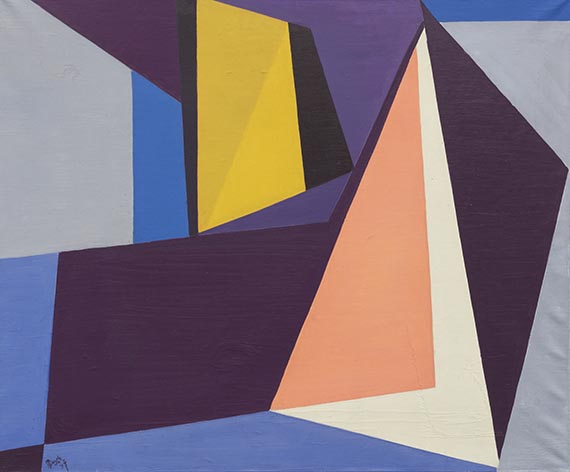58
Otto Ritschl
Komposition 57/12, 1957.
Oil on canvas
Starting bid: € 8,000 / $ 9,440
Komposition 57/12. 1957.
Oil on canvas.
Signed and dated in the lower left. Once more signed and dated as well as inscribed “Ritschl Komp. 57/12" on the reverse. 75 x 90 cm (29.5 x 35.4 in).
[AR].
• Remarkably colorful and precisely organized composition from the artist's strictly abstract period.
• During the course of 1956, Otto Ritschl developed jagged and angular elements that would dominate his compositions for several years.
• His artistic development was influenced by, among other things, his encounter with the Parisian constructivists, which provided new inspiration for his work.
• In both 1955 and 1959, the German artist was represented at the documenta in Kassel.
PROVENANCE: Pachen Collection, Mainz/Rockenhausen (with a label inscribed with the inventory number 0086 on the reverse).
Private collection, Hesse.
EXHIBITION: Pachen Collection. Deutsche Kunstwerke aus dem 20. Jahrhundert. Malerei, Graphik, Plastik, Sonderausstellung im Haus am Dom, Mainz, June 8 - July 1, 1962, cat. no. 78 (illustrated).
Pachen Collection: Eine Auswahl, Mittelrheinisches Landesmuseum, Mainz, Seprember 13 - October 15, 1978, cat. no. 63.
LITERATURE: Wolff Mirus, Otto Ritschl. Das Werkverzeichnis 1919-1976, Munich 2017, catalogue raisonn é no. 1957/12 (illustrated in color on p. 233).
- -
Hans Hofstätter, Sammlung Pachen. Deutsche Kunstwerke aus dem 20. Jahrhundert. Malerei, Graphik, Plastik, Mainz 1960, p. 60 (illustrated on p. 61).
In good condition. Probably with the original artist's or studio frame. Craquelure and soiling in places. Small brown spots on the paint and studio marks. The canvas is slightly wavy in the corners and on the right edge of the picture. The paint application is slightly uneven in the gray area in the lower right, but this is probably original. Under UV light, slight overpainting can be seen in the upper center, but this is also likely to be by the artist himself. The condition report was compiled in daylight with a UV light source and to the best of our knowledge and belief.
Oil on canvas.
Signed and dated in the lower left. Once more signed and dated as well as inscribed “Ritschl Komp. 57/12" on the reverse. 75 x 90 cm (29.5 x 35.4 in).
[AR].
• Remarkably colorful and precisely organized composition from the artist's strictly abstract period.
• During the course of 1956, Otto Ritschl developed jagged and angular elements that would dominate his compositions for several years.
• His artistic development was influenced by, among other things, his encounter with the Parisian constructivists, which provided new inspiration for his work.
• In both 1955 and 1959, the German artist was represented at the documenta in Kassel.
PROVENANCE: Pachen Collection, Mainz/Rockenhausen (with a label inscribed with the inventory number 0086 on the reverse).
Private collection, Hesse.
EXHIBITION: Pachen Collection. Deutsche Kunstwerke aus dem 20. Jahrhundert. Malerei, Graphik, Plastik, Sonderausstellung im Haus am Dom, Mainz, June 8 - July 1, 1962, cat. no. 78 (illustrated).
Pachen Collection: Eine Auswahl, Mittelrheinisches Landesmuseum, Mainz, Seprember 13 - October 15, 1978, cat. no. 63.
LITERATURE: Wolff Mirus, Otto Ritschl. Das Werkverzeichnis 1919-1976, Munich 2017, catalogue raisonn é no. 1957/12 (illustrated in color on p. 233).
- -
Hans Hofstätter, Sammlung Pachen. Deutsche Kunstwerke aus dem 20. Jahrhundert. Malerei, Graphik, Plastik, Mainz 1960, p. 60 (illustrated on p. 61).
In good condition. Probably with the original artist's or studio frame. Craquelure and soiling in places. Small brown spots on the paint and studio marks. The canvas is slightly wavy in the corners and on the right edge of the picture. The paint application is slightly uneven in the gray area in the lower right, but this is probably original. Under UV light, slight overpainting can be seen in the upper center, but this is also likely to be by the artist himself. The condition report was compiled in daylight with a UV light source and to the best of our knowledge and belief.
58
Otto Ritschl
Komposition 57/12, 1957.
Oil on canvas
Starting bid: € 8,000 / $ 9,440
Headquarters
Joseph-Wild-Str. 18
81829 Munich
Phone: +49 89 55 244-0
Fax: +49 89 55 244-177
info@kettererkunst.de
Louisa von Saucken / Undine Schleifer
Holstenwall 5
20355 Hamburg
Phone: +49 40 37 49 61-0
Fax: +49 40 37 49 61-66
infohamburg@kettererkunst.de
Dr. Simone Wiechers / Nane Schlage
Fasanenstr. 70
10719 Berlin
Phone: +49 30 88 67 53-63
Fax: +49 30 88 67 56-43
infoberlin@kettererkunst.de
Cordula Lichtenberg
Gertrudenstraße 24-28
50667 Cologne
Phone: +49 221 510 908-15
infokoeln@kettererkunst.de
Hessen
Rhineland-Palatinate
Miriam Heß
Phone: +49 62 21 58 80-038
Fax: +49 62 21 58 80-595
infoheidelberg@kettererkunst.de
We will inform you in time.




 Lot 58
Lot 58 
